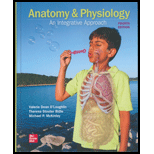
Anatomy & Physiology: An Integrative Approach
4th Edition
ISBN: 9781264265435
Author: Michael McKinley
Publisher: Mcgraw-hill Higher Education (us)
expand_more
expand_more
format_list_bulleted
Concept explainers
Question
Chapter 1.5, Problem 13WDYL
Summary Introduction
To fill: The correct term in the given blank.
Introduction:
A cut formed in the skin during a procedure or surgery is known as an incision. This is also referred to as a surgical wound occasionally. Depending on the type of operation, the size, location, and number of incisions may change.
Expert Solution & Answer
Want to see the full answer?
Check out a sample textbook solution
Students have asked these similar questions
What is the structure and function of Eukaryotic cells, including their organelles? How are Eukaryotic cells different than Prokaryotic cells, in terms of evolution which form of the cell might have came first? How do Eukaryotic cells become malignant (cancerous)?
What are the roles of DNA and proteins inside of the cell? What are the building blocks or molecular components of the DNA and proteins? How are proteins produced within the cell? What connection is there between DNA, proteins, and the cell cycle? What is the relationship between DNA, proteins, and Cancer?
Why cells go through various types of cell division and how eukaryotic cells control cell growth through the cell cycle control system?
Chapter 1 Solutions
Anatomy & Physiology: An Integrative Approach
Ch. 1.1 - What is the relationship between anatomy and...Ch. 1.1 - How might knowledge of surface anatomy be...Ch. 1.1 - Which field of physiology examines how the heart,...Ch. 1.2 - Compare and contrast how anatomists and...Ch. 1.4 - Prob. 6WDYLCh. 1.4 - Prob. 8WDYLCh. 1.5 - Prob. 9WDYLCh. 1.5 - Prob. 10WDYLCh. 1.5 - Prob. 12WDYLCh. 1.5 - Prob. 13WDYL
Ch. 1.6 - List and describe the three components of a...Ch. 1.6 - Prob. 15WDYLCh. 1.6 - Prob. 16WDYLCh. 1.7 - Prob. 17WDYLCh. 1 - Which field of anatomy examines the superficial...Ch. 1 - Prob. 2DYKBCh. 1 - Prob. 3DYKBCh. 1 - Prob. 4DYKBCh. 1 - Prob. 5DYKBCh. 1 - Prob. 6DYKBCh. 1 - Which body cavity is located inferior to the...Ch. 1 - Prob. 8DYKBCh. 1 - Prob. 9DYKBCh. 1 - Prob. 10DYKBCh. 1 - What are the similarities and differences between...Ch. 1 - List the levels of organization in a human,...Ch. 1 - Prob. 13DYKBCh. 1 - Name the organ systems in the human body.Ch. 1 - Describe the body in the anatomic position. Why is...Ch. 1 - List the anatomic term that describes each of the...Ch. 1 - What are the two body cavities within the...Ch. 1 - Describe the structure and function of serous...Ch. 1 - What are the main components in a homeostatic...Ch. 1 - Prob. 20DYKBCh. 1 - Your friend Eric complains of some pain in his...Ch. 1 - Your friend Eric complains of some pain in his...Ch. 1 - Your friend Eric complains of some pain in his...Ch. 1 - When you are outside on a hot, humid day, what...Ch. 1 - A friend just started taking Zoloft (an SSRI) and...Ch. 1 - Lynn was knocked off her bicycle during a race....Ch. 1 - Prob. 2CSLCh. 1 - Prob. 3CSL
Knowledge Booster
Learn more about
Need a deep-dive on the concept behind this application? Look no further. Learn more about this topic, biology and related others by exploring similar questions and additional content below.Similar questions
- In one paragraph show how atoms and they're structure are related to the structure of dna and proteins. Talk about what atoms are. what they're made of, why chemical bonding is important to DNA?arrow_forwardWhat are the structure and properties of atoms and chemical bonds (especially how they relate to DNA and proteins).arrow_forwardThe Sentinel Cell: Nature’s Answer to Cancer?arrow_forward
- Molecular Biology Question You are working to characterize a novel protein in mice. Analysis shows that high levels of the primary transcript that codes for this protein are found in tissue from the brain, muscle, liver, and pancreas. However, an antibody that recognizes the C-terminal portion of the protein indicates that the protein is present in brain, muscle, and liver, but not in the pancreas. What is the most likely explanation for this result?arrow_forwardMolecular Biology Explain/discuss how “slow stop” and “quick/fast stop” mutants wereused to identify different protein involved in DNA replication in E. coli.arrow_forwardMolecular Biology Question A gene that codes for a protein was removed from a eukaryotic cell and inserted into a prokaryotic cell. Although the gene was successfully transcribed and translated, it produced a different protein than it produced in the eukaryotic cell. What is the most likely explanation?arrow_forward
- Molecular Biology LIST three characteristics of origins of replicationarrow_forwardMolecular Biology Question Please help. Thank you For E coli DNA polymerase III, give the structure and function of the b-clamp sub-complex. Describe how the structure of this sub-complex is important for it’s function.arrow_forwardMolecular Biology LIST three characteristics of DNA Polymerasesarrow_forward
arrow_back_ios
SEE MORE QUESTIONS
arrow_forward_ios
Recommended textbooks for you
 Medical Terminology for Health Professions, Spira...Health & NutritionISBN:9781305634350Author:Ann Ehrlich, Carol L. Schroeder, Laura Ehrlich, Katrina A. SchroederPublisher:Cengage LearningEssentials of Pharmacology for Health ProfessionsNursingISBN:9781305441620Author:WOODROWPublisher:Cengage
Medical Terminology for Health Professions, Spira...Health & NutritionISBN:9781305634350Author:Ann Ehrlich, Carol L. Schroeder, Laura Ehrlich, Katrina A. SchroederPublisher:Cengage LearningEssentials of Pharmacology for Health ProfessionsNursingISBN:9781305441620Author:WOODROWPublisher:Cengage

Medical Terminology for Health Professions, Spira...
Health & Nutrition
ISBN:9781305634350
Author:Ann Ehrlich, Carol L. Schroeder, Laura Ehrlich, Katrina A. Schroeder
Publisher:Cengage Learning


Essentials of Pharmacology for Health Professions
Nursing
ISBN:9781305441620
Author:WOODROW
Publisher:Cengage

Dissection Basics | Types and Tools; Author: BlueLink: University of Michigan Anatomy;https://www.youtube.com/watch?v=-_B17pTmzto;License: Standard youtube license